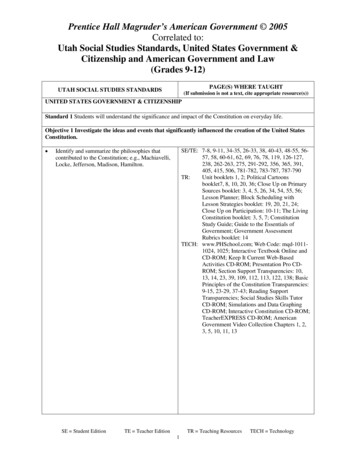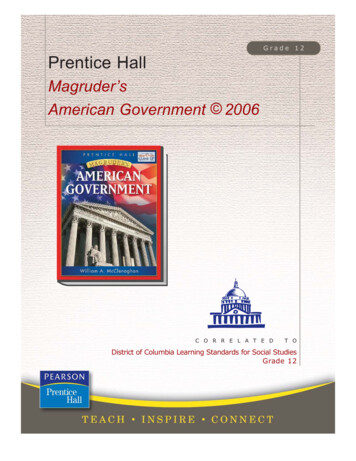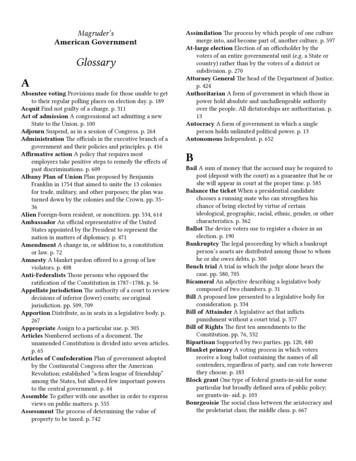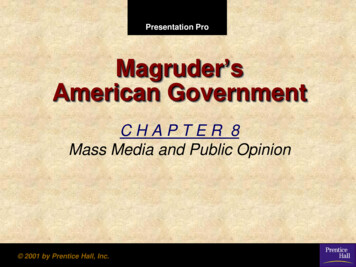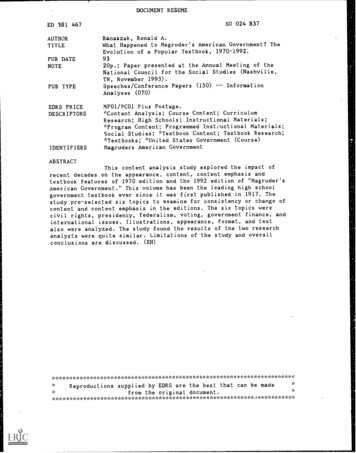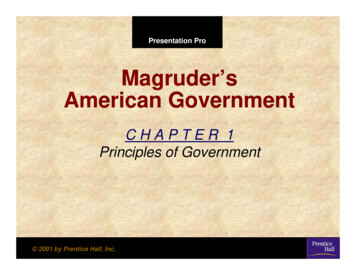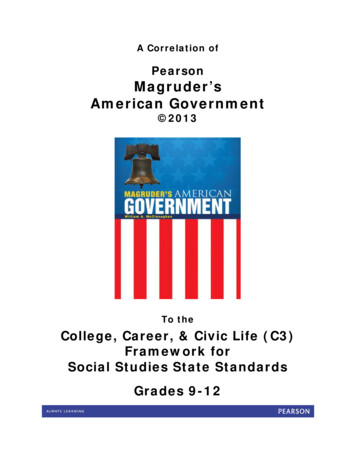
Transcription
A Correlation ofPearsonMagruder’sAmerican Government 2013To theCollege, Career, & Civic Life (C3)Framework forSocial Studies State StandardsGrades 9-12
A Correlation of Pearson Magruder’s American Government, 2013to the C3 Framework for Social Studies State StandardsIntroductionThis document demonstrates how Magruder’s American Government, 2013, meetsthe C3 Framework for Social Studies State Standards, Grades 9-12. Correlation pagereferences are to the Student and Teacher Editions.Hailed as a stellar educational resource since 1917, Magruder’s American Government isupdated annually so students can explore the most current, most authoritative Americangovernment content. It’s clear, appealing narrative and engaging technology are enhancedwith Essential Questions, numerous primary sources, and interactive online activities.Various personalized instruction opportunities motivate students of all abilities. Essential Questions and trusted content: Each unit and chapter introducesstudents to Essential Questions of American Government. Magruder’s is the mosttrusted and authoritative program in the nation. Exciting new technology: Rich digital learning support on the Online StudentCenter includes Government on the Go Audio and Video resources, interactiveassessment, two levels of online Student Editions, and more! The Online TeacherCenter includes two online Teacher Editions, online planning and assessment, lecturenotes, and easy-to-use classroom management tools. Personalized instruction so all students can learn: With the Teacher ResourceLibrary DVD-ROM and Online Teacher Center, teachers can choose from among themany leveled, editable, teaching worksheets and assessment resources that havebeen especially written to meet the needs of students reading below grade level. Magruder’s American Government curriculum is aligned with FoundationsSeries: American Government.2
A Correlation of Pearson Magruder’s American Government, 2013to the C3 Framework for Social Studies State StandardsTable of ContentsUnited States Constitution . 4Unit 1: Foundations of American Government . 4Unit 2: Political Behavior: Government By the People . 29Unit 3: The Legislative Branch . 59Unit 4: The Executive Branch . 72Unit 5: The Judicial Branch . 98Unit 6: Comparative Political and Economic Systems . 128Unit 7: Participating in State and Local Government . 136C3 Grades 9-12 Dimensions . 1473
A Correlation of Pearson Magruder’s American Government, 2013to the C3 Framework for Social Studies State StandardsPearson Magruder’sAmerican Government, 2013C3 Framework for Social StudiesState StandardsUnited States ConstitutionConstitution Quick Study GuideUnited States ConstitutionSE/TE: C1-C15D2.Civ.1.9-12. Distinguish the powers andresponsibilities of local, state, tribal,national, and international civic and politicalinstitutions.D2.Civ.4.9-12. Explain how the U.S.Constitution establishes a system ofgovernment that has powers,responsibilities, and limits that havechanged over time and that are stillcontested.D2.Civ.5.9-12. Evaluate citizens’ andinstitutions’ effectiveness in addressingsocial and political problems at the local,state, tribal, national, and/or internationallevel.D2.Civ.6.9-12. Critique relationshipsamong governments, civil societies, andeconomic markets.AmendmentsSE/TE: C16-C23Unit 1: Foundations of American GovernmentChapter 1: Principles of GovernmentD1.1.9-12. Explain how a question reflectsEssential Questionan enduring issue in the field.D2.Civ.1.9-12. Distinguish the powers andGovernment Onlineresponsibilities of local, state, tribal,SE/TE: 2-3national, and international civic and politicalinstitutions.D2.Civ.4.9-12. Explain how the U.S.Constitution establishes a system ofgovernment that has powers,responsibilities, and limits that havechanged over time and that are stillcontested.D2.Civ.14.9-12. Analyze historical,contemporary, and emerging means ofchanging societies, promoting the commongood, and protecting rights.Section 1: Government and the StateSE/TE: 4-11Government OnlineSE/TE: 6, 8D1.1.9-12. Explain how a question reflectsan enduring issue in the field.D2.Civ.1.9-12. Distinguish the powers andresponsibilities of local, state, tribal,national, and international civic and politicalinstitutions.D2.Civ.8.9-12. Evaluate social and politicalsystems in different contexts, times, andplaces, that promote civic virtues and enactdemocratic principles.Assessment: Essential Questions Journal,Guiding Question, Key Terms andComprehension, Critical Thinking, QuickWrite: Expository, Ask a QuestionSE/TE: 114
A Correlation of Pearson Magruder’s American Government, 2013to the C3 Framework for Social Studies State StandardsPearson Magruder’sAmerican Government, 2013C3 Framework for Social StudiesState StandardsSection 2: Forms of GovernmentSE/TE: 12-18Government OnlineSE/TE: 15D1.1.9-12. Explain how a question reflectsan enduring issue in the field.D2.Civ.1.9-12. Distinguish the powers andresponsibilities of local, state, tribal,national, and international civic and politicalinstitutions.D2.Civ.8.9-12. Evaluate social and politicalsystems in different contexts, times, andplaces, that promote civic virtues and enactdemocratic principles.D2.Civ.10.9-12. Analyze the impact andthe appropriate roles of personal interestsand perspectives on the application of civicvirtues, democratic principles, constitutionalrights, and human rights.D2.Civ.11.9-12. Evaluate multipleprocedures for making governmentaldecisions at the local, state, national, andinternational levels in terms of the civicpurposes achieved.D2.Geo.5.9-12. Evaluate how political andeconomic decisions throughout time haveinfluenced cultural and environmentalcharacteristics of various places andregions.D2.His.14.9-12. Analyze multiple andcomplex causes and effects of events in thepast.D3.1.9-12. Gather relevant informationfrom multiple sources representing a widerange of views while using the origin,authority, structure, context, andcorroborative value of the sources to guidethe selection.Assessment: Essential Questions Journal,Guiding Question, Key Terms andComprehension, Critical Thinking, QuickWrite: Expository, Research Your TopicSE/TE: 18Citizenship 101: VolunteeringGovernment OnlineSE/TE: 19D3.1.9-12. Gather relevant informationfrom multiple sources representing a widerange of views while using the origin,authority, structure, context, andcorroborative value of the sources to guidethe selection.D4.7.9-12. Assess options for individualand collective action to address local,regional, and global problems by engagingin self-reflection, strategy identification,and complex causal reasoning.5
A Correlation of Pearson Magruder’s American Government, 2013to the C3 Framework for Social Studies State StandardsPearson Magruder’sAmerican Government, 2013C3 Framework for Social StudiesState StandardsSection 3: Basic Concepts of DemocracySE/TE: 20-25D1.1.9-12. Explain how a question reflectsan enduring issue in the field.D2.Civ.1.9-12. Distinguish the powers andresponsibilities of local, state, tribal,national, and international civic and politicalinstitutions.D2.Civ.4.9-12. Explain how the U.S.Constitution establishes a system ofgovernment that has powers,responsibilities, and limits that havechanged over time and that are stillcontested.D2.Civ.11.9-12. Evaluate multipleprocedures for making governmentaldecisions at the local, state, national, andinternational levels in terms of the civicpurposes achieved.Assessment: Essential Questions Journal,Guiding Question, Key Terms andComprehension, Critical Thinking, QuickWrite: Expository, Create an OutlineSE/TE: 24Quick Study GuideGovernment OnlineSE/TE: 25D1.1.9-12. Explain how a question reflectsan enduring issue in the field.D1.4.9-12. Explain how supportingquestions contribute to an inquiry and how,through engaging source work, newcompelling and supporting questionsemerge.D1.5.9-12. Determine the kinds of sourcesthat will be helpful in answering compellingand supporting questions, taking intoconsideration multiple points of viewrepresented in the sources, the types ofsources available, and the potential uses ofthe sources.D2.Civ.1.9-12. Distinguish the powers andresponsibilities of local, state, tribal,national, and international civic and politicalinstitutions.D2.Civ.4.9-12. Explain how the U.S.Constitution establishes a system ofgovernment that has powers,responsibilities, and limits that havechanged over time and that are stillcontested.D3.1.9-12. Gather relevant informationfrom multiple sources representing a widerange of views while using the origin,authority, structure, context, andcorroborative value of the sources to guidethe selection.Chapter AssessmentComprehension and Critical Thinking, ApplyWhat You’ve Learned,Essential Question Activity,Essential Question AssessmentSE/TE: 26Document-Based AssessmentThe Roots of DemocracyGovernment OnlineSE/TE: 276
A Correlation of Pearson Magruder’s American Government, 2013to the C3 Framework for Social Studies State StandardsPearson Magruder’sAmerican Government, 2013C3 Framework for Social StudiesState Standards(Continued)Quick Study GuideGovernment OnlineSE/TE: 25(Continued)D3.2.9-12. Evaluate the credibility of asource by examining how experts value thesource.D3.3.9-12. Identify evidence that drawsinformation directly and substantively frommultiple sources to detect inconsistencies inevidence in order to revise or strengthenclaims.D4.2.9-12. Construct explanations usingsound reasoning, correct sequence (linearor non-linear), examples, and details withsignificant and pertinent information anddata, while acknowledging the strengthsand weaknesses of the explanation given itspurpose (e.g., cause and effect,chronological, procedural, technical).Chapter AssessmentComprehension and Critical Thinking, ApplyWhat You’ve Learned,Essential Question Activity,Essential Question AssessmentSE/TE: 26Document-Based AssessmentThe Roots of DemocracyGovernment OnlineSE/TE: 27Chapter 2: Origins of AmericanGovernmentEssential QuestionGovernment OnlineSE/TE: 28-29D1.1.9-12. Explain how a question reflectsan enduring issue in the field.D2.Civ.4.9-12. Explain how the U.S.Constitution establishes a system ofgovernment that has powers,responsibilities, and limits that havechanged over time and that are stillcontested.7
A Correlation of Pearson Magruder’s American Government, 2013to the C3 Framework for Social Studies State StandardsPearson Magruder’sAmerican Government, 2013C3 Framework for Social StudiesState StandardsSection 1: Our Political BeginningsSE/TE: 30-34D1.1.9-12. Explain how a question reflectsan enduring issue in the field.D2.Civ.1.9-12. Distinguish the powers andresponsibilities of local, state, tribal,national, and international civic and politicalinstitutions.D2.Civ.3.9-12. Analyze the impact ofconstitutions, laws, treaties, andinternational agreements on themaintenance of national and internationalorder.D2.His.1.9-12. Evaluate how historicalevents and developments were shaped byunique circumstances of time and place aswell as broader historical contexts.D2.His.2.9-12. Analyze change andcontinuity in historical eras.D2.His.14.9-12. Analyze multiple andcomplex causes and effects of events in thepast.D3.1.9-12. Gather relevant informationfrom multiple sources representing a widerange of views while using the origin,authority, structure, context, andcorroborative value of the sources to guidethe selection.Government OnlineSE/TE: 32Assessment: Essential Questions Journal,Guiding Question, Key Terms andComprehension, Critical Thinking, QuickWrite: Narrative, Choose a ColonySE/TE: 34Section 1: Our Political BeginningsSE/TE: 30-34Government OnlineSE/TE: 32Assessment: Essential Questions Journal,Guiding Question, Key Terms andComprehension, Critical Thinking, QuickWrite: Narrative, Choose a ColonySE/TE: 34Issues of Our Time: Transitions toDemocracyGovernment OnlineSE/TE: 35D3.1.9-12. Gather relevant informationfrom multiple sources representing a widerange of views while using the origin,authority, structure, context, andcorroborative value of the sources to guidethe selection.D3.3.9-12. Identify evidence that drawsinformation directly and substantively frommultiple sources to detect inconsistencies inevidence in order to revise or strengthenclaims.D4.1.9-12. Construct arguments usingprecise and knowledgeable claims, withevidence from multiple sources, whileacknowledging counterclaims andevidentiary weaknesses.8
A Correlation of Pearson Magruder’s American Government, 2013to the C3 Framework for Social Studies State StandardsPearson Magruder’sAmerican Government, 2013C3 Framework for Social StudiesState StandardsSection 2: The Coming of IndependenceSE/TE: 36-42D1.1.9-12. Explain how a question reflectsan enduring issue in the field.D2.Civ.2.9-12. Analyze the role of citizensin the U.S. political system, with attentionto various theories of democracy, changesin Americans’ participation over time, andalternative models from other countries,past and present.D2.Civ.3.9-12. Analyze the impact ofconstitutions, laws, treaties, andinternational agreements on themaintenance of national and internationalorder.D2.Civ.6.9-12. Critique relationshipsamong governments, civil societies, andeconomic markets.D2.Civ.12.9-12. Analyze how people useand challenge local, state, national, andinternational laws to address a variety ofpublic issues.D2.Civ.14.9-12. Analyze historical,contemporary, and emerging means ofchanging societies, promoting the commongood, and protecting rights.D2.His.1.9-12. Evaluate how historicalevents and developments were shaped byunique circumstances of time and place aswell as broader historical contexts.D2.His.2.9-12. Analyze change andcontinuity in historical eras.D2.His.14.9-12. Analyze multiple andcomplex causes and effects of events in thepast.Government OnlineSE/TE: 39Assessment: Essential Questions Journal,Guiding Question, Key Terms andComprehension, Critical Thinking, QuickWrite: Narrative, Research Your ColonySE/TE: 429
A Correlation of Pearson Magruder’s American Government, 2013to the C3 Framework for Social Studies State StandardsPearson Magruder’sAmerican Government, 2013The Declaration of IndependenceSE/TE: 43-47Reviewing the Declaration: Vocabulary,Comprehension, Critical ThinkingSE/TE: 47C3 Framework for Social StudiesState StandardsD2.Civ.3.9-12. Analyze the impact ofconstitutions, laws, treaties, andinternational agreements on themaintenance of national and internationalorder.D2.Civ.14.9-12. Analyze historical,contemporary, and emerging means ofchanging societies, promoting the commongood, and protecting rights.D2.His.1.9-12. Evaluate how historicalevents and developments were shaped byunique circumstances of time and place aswell as broader historical contexts.D2.His.14.9-12. Analyze multiple andcomplex causes and effects of events in thepast.D3.1.9-12. Gather relevant informationfrom multiple sources representing a widerange of views while using the origin,authority, structure, context, andcorroborative value of the sources to guidethe selection.D3.2.9-12. Evaluate the credibility of asource by examining how experts value thesource.D3.3.9-12. Identify evidence that drawsinformation directly and substantively frommultiple sources to detect inconsistencies inevidence in order to revise or strengthenclaims.10
A Correlation of Pearson Magruder’s American Government, 2013to the C3 Framework for Social Studies State StandardsPearson Magruder’sAmerican Government, 2013Section 3: The Critical PeriodSE/TE: 48-51Assessment: Essential Questions Journal,Guiding Question, Key Terms andComprehension, Critical Thinking, QuickWrite: Narrative, Details and AnecdotesSE/TE: 51C3 Framework for Social StudiesState StandardsD1.1.9-12. Explain how a question reflectsan enduring issue in the field.D2.Civ.1.9-12. Distinguish the powers andresponsibilities of local, state, tribal,national, and international civic and politicalinstitutions.D2.Civ.2.9-12. Analyze the role of citizensin the U.S. political system, with attentionto various theories of democracy, changesin Americans’ participation over time, andalternative models from other countries,past and present.D2.Civ.3.9-12. Analyze the impact ofconstitutions, laws, treaties, andinternational agreements on themaintenance of national and internationalorder.D2.Civ.5.9-12. Evaluate citizens’ andinstitutions’ effectiveness in addressingsocial and political problems at the local,state, tribal, national, and/or internationallevel.D2.Civ.8.9-12. Evaluate social and politicalsystems in different contexts, times, andplaces, that promote civic virtues and enactdemocratic principles.D2.Civ.11.9-12. Evaluate multipleprocedures for making governmentaldecisions at the local, state, national, andinternational levels in terms of the civicpurposes achieved.D2.Civ.12.9-12. Analyze how people useand challenge local, state, national, andinternational laws to address a variety ofpublic issues.D2.Civ.14.9-12. Analyze historical,contemporary, and emerging means ofchanging societies, promoting the commongood, and protecting rights.D2.His.1.9-12. Evaluate how historicalevents and developments were shaped byunique circumstances of time and place aswell as broader historical contexts.D2.His.2.9-12. Analyze change andcontinuity in historical eras.D2.His.14.9-12. Analyze multiple andcomplex causes and effects of events in thepast.11
A Correlation of Pearson Magruder’s American Government, 2013to the C3 Framework for Social Studies State StandardsPearson Magruder’sAmerican Government, 2013Section 4: Creating the ConstitutionSE/TE: 52-58Government OnlineSE/TE: 53, 55Assessment: Essential Questions Journal,Guiding Question, Key Terms andComprehension, Critical Thinking, QuickWrite: Narrative, Choose a Main IdeaSE/TE: 58C3 Framework for Social StudiesState StandardsD1.1.9-12. Explain how a question reflectsan enduring issue in the field.D2.Civ.1.9-12. Distinguish the powers andresponsibilities of local, state, tribal,national, and international civic and politicalinstitutions.D2.Civ.2.9-12. Analyze the role of citizensin the U.S. political system, with attentionto various theories of democracy, changesin Americans’ participation over time, andalternative models from other countries,past and present.D2.Civ.3.9-12. Analyze the impact ofconstitutions, laws, treaties, andinternational agreements on themaintenance of national and internationalorder.D2.Civ.4.9-12. Explain how the U.S.Constitution establishes a system ofgovernment that has powers,responsibilities, and limits that havechanged over time and that are stillcontested.D2.Civ.8.9-12. Evaluate social and politicalsystems in different contexts, times, andplaces, that promote civic virtues and enactdemocratic principles.D2.Civ.14.9-12. Analyze historical,contemporary, and emerging means ofchanging societies, promoting the commongood, and protecting rights.D2.His.1.9-12. Evaluate how historicalevents and developments were shaped byunique circumstances of time and place aswell as broader historical contexts.D2.His.2.9-12. Analyze change andcontinuity in historical eras.D2.His.14.9-12. Analyze multiple andcomplex causes and effects of events in thepast.12
A Correlation of Pearson Magruder’s American Government, 2013to the C3 Framework for Social Studies State StandardsPearson Magruder’sAmerican Government, 2013Section 5: Ratifying the ConstitutionSE/TE: 59-62Government OnlineSE/TE: 60Assessment: Essential Questions Journal,Guiding Question, Key Terms andComprehension, Critical Thinking, QuickWrite: Narrative, Create an OutlineSE/TE: 62C3 Framework for Social StudiesState StandardsD1.1.9-12. Explain how a question reflectsan enduring issue in the field.D2.His.1.9-12. Evaluate how historicalevents and developments were shaped byunique circumstances of time and place aswell as broader historical contexts.D2.Civ.4.9-12. Explain how the U.S.Constitution establishes a system ofgovernment that has powers,responsibilities, and limits that havechanged over time and that are stillcontested.D2.Civ.8.9-12. Evaluate social and politicalsystems in different contexts, times, andplaces, that promote civic virtues and enactdemocratic principles.D2.Civ.14.9-12. Analyze historical,contemporary, and emerging means ofchanging societies, promoting the commongood, and protecting rights.D2.His.2.9-12. Analyze change andcontinuity in historical eras.D2.His.14.9-12. Analyze multiple andcomplex causes and effects of events in thepast.D2.His.16.9-12. Integrate evidence frommultiple relevant historical sources and interpretations into a reasoned argumentabout the past.D3.1.9-12. Gather relevant informationfrom multiple sources representing a widerange of views while using the origin,authority, structure, context, andcorroborative value of the sources to guidethe selection.13
A Correlation of Pearson Magruder’s American Government, 2013to the C3 Framework for Social Studies State StandardsPearson Magruder’sAmerican Government, 2013Quick Study GuideGovernment OnlineSE/TE: 63Chapter 2 Chapter Assessment:Comprehension and Critical ThinkingEssential Question, Essential Question,Essential Question JournalGovernment OnlineSE/TE: 64Document-Based Assessment:The Constitution and the Revolutionary WarEraGovernment OnlineSE/TE: 65C3 Framework for Social StudiesState StandardsD1.1.9-12. Explain how a question reflectsan enduring issue in the field.D1.4.9-12. Explain how supportingquestions contribute to an inquiry and how,through engaging source work, newcompelling and supporting questionsemerge.D1.5.9-12. Determine the kinds of sourcesthat will be helpful in answering compellingand supporting questions, taking intoconsideration multiple points of viewrepresented in the sources, the types ofsources available, and the potential uses ofthe sources.D2.Civ.3.9-12. Analyze the impact ofconstitutions, laws, treaties, andinternational agreements on themaintenance of national and internationalorder.D2.Civ.4.9-12. Explain how the U.S.Constitution establishes a system ofgovernment that has powers,responsibilities, and limits that havechanged over time and that are stillcontested.D2.Civ.8.9-12. Evaluate social and politicalsystems in different contexts, times, andplaces, that promote civic virtues and enactdemocratic principles.D2.Civ.10.9-12. Analyze the impact andthe appropriate roles of personal interestsand perspectives on the application of civicvirtues, democratic principles, constitutionalrights, and human rights.D2.His.14.9-12. Analyze multiple andcomplex causes and effects of events in thepast.D3.1.9-12. Gather relevant informationfrom multiple sources representing a widerange of views while using the origin,authority, structure, context, andcorroborative value of the sources to guidethe selection.D3.2.9-12. Evaluate the credibility of asource by examining how experts value thesource.14
A Correlation of Pearson Magruder’s American Government, 2013to the C3 Framework for Social Studies State StandardsPearson Magruder’sAmerican Government, 2013(Continued)Quick Study GuideGovernment OnlineSE/TE: 63Chapter 2 Chapter Assessment:Comprehension and Critical ThinkingEssential Question, Essential Question,Essential Question JournalGovernment OnlineSE/TE: 64Document-Based Assessment:The Constitution and the Revolutionary WarEraGovernment OnlineSE/TE: 65Chapter 3: The ConstitutionEssential QuestionS Government OnlineE/TE: 66-67C3 Framework for Social StudiesState Standards(Continued)D3.3.9-12. Identify evidence that drawsinformation directly and substantively frommultiple sources to detect inconsistencies inevidence in order to revise or strengthenclaims.D4.2.9-12. Construct explanations usingsound reasoning, correct sequence (linearor non-linear), examples, and details withsignificant and pertinent information anddata, while acknowledging the strengthsand weaknesses of the explanation given itspurpose (e.g., cause and effect,chronological, procedural, technical).D4.3.9-12. Present adaptations ofarguments and explanations that featureevocative ideas and perspectives on issuesand topics to reach a range of audiencesand venues outside the classroom usingprint and oral technologies (e.g., posters,essays, letters, debates, speeches, reports,and maps) and digital technologies (e.g.,Internet, social media, and digitaldocumentary).D1.1.9-12. Explain how a question reflectsan enduring issue in the field.D2.Civ.4.9-12. Explain how the U.S.Constitution establishes a system ofgovernment that has powers,responsibilities, and limits that havechanged over time and that are stillcontested.15
A Correlation of Pearson Magruder’s American Government, 2013to the C3 Framework for Social Studies State StandardsPearson Magruder’sAmerican Government, 2013Section 1: Basic PrinciplesSE/TE: 68-75Government OnlineSE/TE: 71, 73Assessment: Essential Questions Journal,Guiding Question, Key Terms, CriticalThinking, Quick Write: Writing forAssessment, Develop a Main IdeaSE/TE: 75C3 Framework for Social StudiesState StandardsD1.1.9-12. Explain how a question reflectsan enduring issue in the field.D2.Civ.1.9-12. Distinguish the powers andresponsibilities of local, state, tribal,national, and international civic and politicalinstitutions.D2.Civ.2.9-12. Analyze the role of citizensin the U.S. political system, with attentionto various theories of democracy, changesin Americans’ participation over time, andalternative models from other countries,past and present.D2.Civ.4.9-12. Explain how the U.S.Constitution establishes a system ofgovernment that has powers,responsibilities, and limits that havechanged over time and that are stillcontested.D2.Civ.8.9-12. Evaluate social and politicalsystems in different contexts, times, andplaces, that promote civic virtues and enactdemocratic principles.16
A Correlation of Pearson Magruder’s American Government, 2013to the C3 Framework for Social Studies State StandardsPearson Magruder’sAmerican Government, 2013Landmark Decisions of the SupremeCourt: Marbury vs. Madison, 1803SE/TE: 76-77C3 Framework for Social StudiesState StandardsD1.1.9-12. Explain how a question reflectsan enduring issue in the field.D2.Civ.1.9-12. Distinguish the powers andresponsibilities of local, state, tribal,national, and international civic and politicalinstitutions.D2.Civ.2.9-12. Analyze the role of citizensin the U.S. political system, with attentionto various theories of democracy, changesin Americans’ participation over time, andalternative models from other countries,past and present.D2.Civ.4.9-12. Explain how the U.S.Constitution establishes a system ofgovernment that has powers,responsibilities, and limits that havechanged over time and that are stillcontested.D2.Civ.10.9-12. Analyze the impact andthe appropriate roles of personal interestsand perspectives on the application of civicvirtues, democratic principles, constitutionalrights, and human rights.D2.Civ.11.9-12. Evaluate multipleprocedures for making governmentaldecisions at the local, state, national, andinternational levels in terms of the civicpurposes achieved.17
A Correlation of Pearson Magruder’s American Government, 2013to the C3 Framework for Social Studies State StandardsPearson Magruder’sAmerican Government, 2013Section 2: Formal AmendmentSE/TE: 78-83Government OnlineSE/TE: 79, 81Assessment: Essential Questions Journal,Guiding Question, Key Terms, CriticalThinking, Quick Write: Writing forAssessment, Gather DetailsSE/TE: 83C3 Framework for Social StudiesState StandardsD1.1.9-12. Explain how a question reflectsan enduring issue in the field.D2.Civ.4.9-12. Explain how the U.S.Constitution establishes a system ofgovernment that has powers,responsibilities, and limits that havechanged over time and that are stillcontested.D2.Civ.5.9-12. Evaluate citizens’ andinstitutions’ effectiveness in addressingsocial and political problems at the local,state, tribal, national, and/or internationallevel.D2.Civ.11.9-12. Evaluate multipleprocedures for making governmentaldecisions at the local, state, national, andinternational levels in terms of the civicpurposes achieved.D2.Civ.12.9-12. Analyze how people useand challenge local, state, national, andinternational laws to address a variety ofpublic issues.D2.Civ.14.9-12. Analyze historical,contemporary, and emerging means ofchanging societies, promoting the commongood, and protecting rights.D2.His.1.9-12. Evaluate how historicalevents and developments were shaped byunique circumstances of time and place aswell as broader historical contexts.D2.His.14.9-12. Analyze multiple andcomplex causes and effects of events in thepast.18
A Correlation of Pearson Magruder’s American Government, 2013to the C3 Framework for Social Studies State StandardsPearson Magruder’sAmerican Government, 2013C3 Framework for Social StudiesState StandardsCitizenship 101: Identifying Political Rootsand AttitudesGovernment OnlineSE/TE: 84D2.Civ.7.9-12. Apply civic virtues anddemocratic principles when working withothers.D2.Civ.8.9-12. Evaluate social and politicalsystems in different contexts, times, andplaces, that promote civic virtues and enactdemocratic principles.D2.Civ.9.9-12. Use appropriatedeliberative processes in multiple settings.D2.Civ.12.9-12. Analyze how people useand challenge local, state, national, andinternational laws to address a variety ofpublic issues.D
This document demonstrates how Magruder's American Government, 2013, meets the C3 Framework for Social Studies State Standards, Grades 9 -12. Correlation page references are to the Student and Teacher Editions. Hailed as a stellar educational resource since 1917, Magruder's American Government is
